A hunger cliff is here.
Millions of people who rely on support from the Supplemental Nutrition Assistance Program (SNAP) have seen their benefits drop – in many cases, dramatically.
During the COVID-19 pandemic, Congress increased SNAP benefits through Emergency Allotments (EAs) to help mitigate America’s deepening hunger crisis, but these temporary boosts are ending.
On March 1, 2023, all SNAP recipients have suffered cuts to their benefits each month.
Combined with soaring food prices and skyrocketing heating, transportation, and housing costs, our nation is facing a hunger cliff. The average SNAP benefits have fallen to a meager $6 a person a day.
The steepest cliff has been for older adults at the minimum benefit level who saw their monthly SNAP benefits fall from $281 to $23. In addition, on May 11, 2023, the COVID-19 federal public health emergency (PHE) ended. The PHE unwinding of temporary changes to programs will have ramifications on some SNAP enrollment procedures and eligibility rules for college students and unemployed and underemployed adults.
Further resources on the PHE are below.
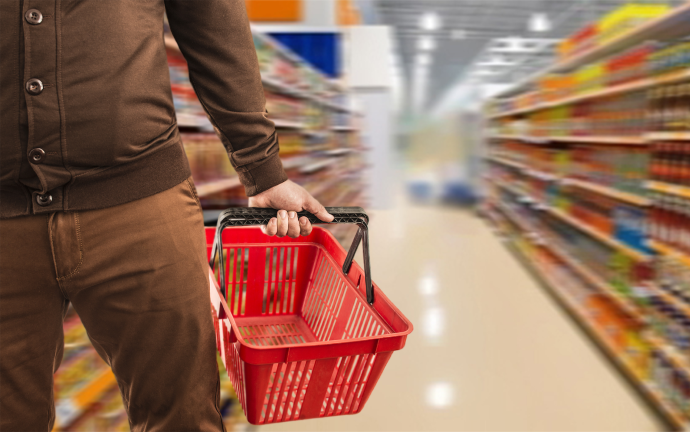
The Hunger Cliff: Documenting The Impact on SNAP Recipients
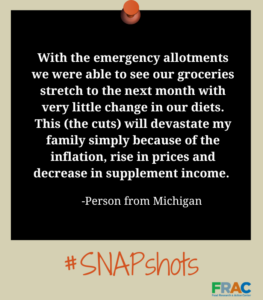
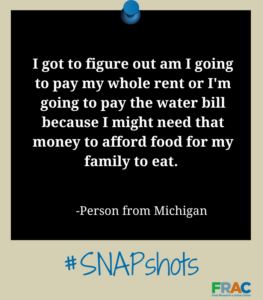
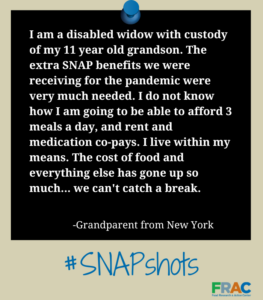
Unwinding the Public Health Emergency: Timeline of the Impacts on SNAP
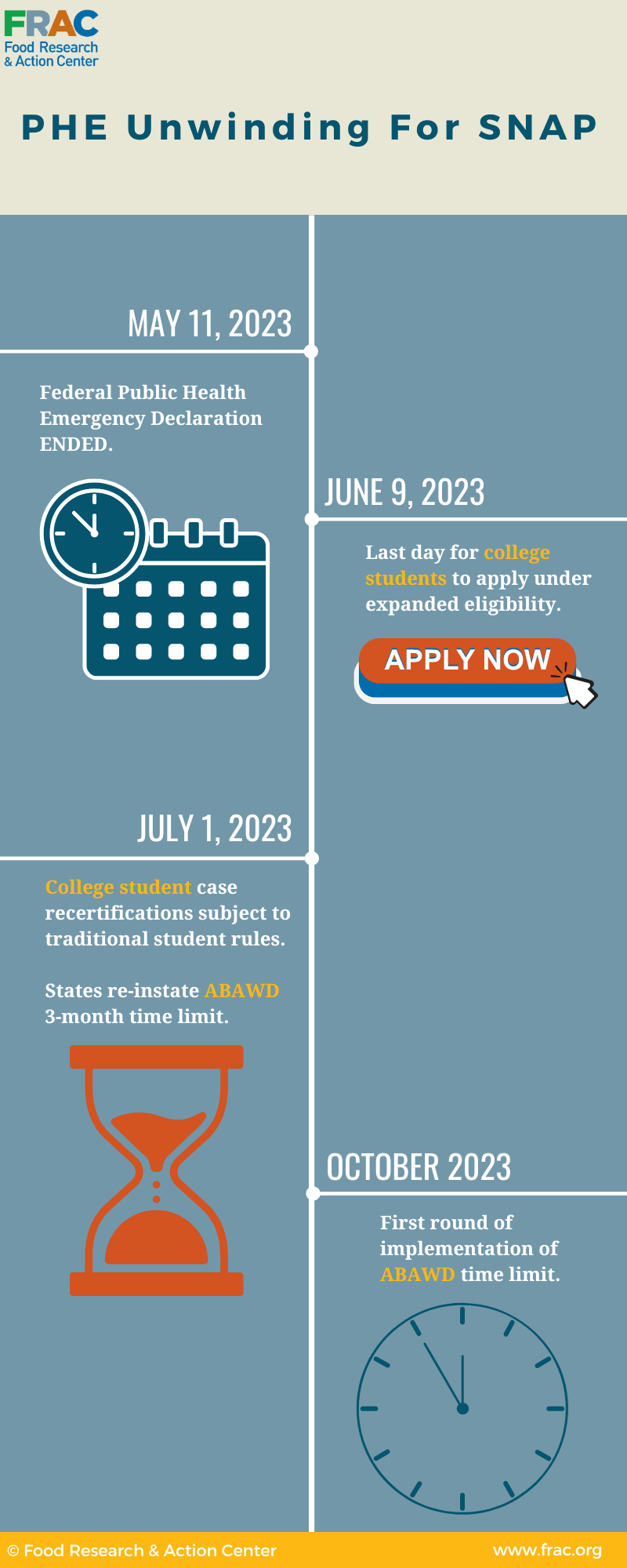
Getting the Word Out: State Best Practices
- California
- End of COVID Flexibilities Client Resources
- Find flyers, frequently asked questions, and sample social media from California’s Department of Social Services
- End of CalFresh Emergency Allotments FAQ
- When Emergency Allotments End CalFresh Flyer
- End of COVID Flexibilities Client Resources
- Colorado
- Colorado SNAP Emergency Allotment benefits ending resources
- Find frequently asked questions and tips for families from Colorado’s Department of Human Services
- Colorado SNAP Emergency Allotment benefits ending resources
- Massachusetts
- Federal SNAP Emergency Allotment Ending Toolkit
- Find flyers, social media text and graphics, and sample robocall, -text, and -email from the Massachusetts Department of Transitional Assistance
- Federal SNAP Emergency Allotment Ending Toolkit
- New York
- Hunger Solutions New York COVID-19 Updates
- Find SNAP-related updates from Hunger Solutions New York
- Hunger Solutions New York COVID-19 Updates
- Pennsylvania
- End of SNAP Extra Payments Communications Toolkit
- Find newsletter messaging, social media samples, and printables from the Pennsylvania Department of Human Services.
- End of SNAP Extra Payments Communications Toolkit
Mitigating the Loss of EAs: State Legislation
- CaliforniaSB 600 – California CalFresh Minimum Benefit Adequacy Act of 2023
“This bill would require the California Department of Social Services to provide additional CalFresh nutrition assistance, ensuring all participating households receive a minimum monthly benefit of $50. “
- Massachusetts
- New Jersey
- New YorkOn April 4, 2023, New York State Assembly Member Jessica González-Rojas introduced A.6214, which would establish a state minimum SNAP benefit to make up the difference between the federal monthly benefit and $95. The legislation has been referred to the Assembly’s Social Services Committee.
To read the bill text, visit the New York State Assembly website.
- Washington, D.C.The Give SNAP a Raise Amendment Act was passed by D.C. Council in December 2022. The bill would increase the monthly SNAP payment a household receives by providing a locally-funded benefit equal to 10 percent of the household’s maximum federal monthly benefit. D.C. Council unanimously passed an amendment in the fiscal year 2024 budget to fund Give SNAP a Raise.

Tools You Can Use In Your Advocacy
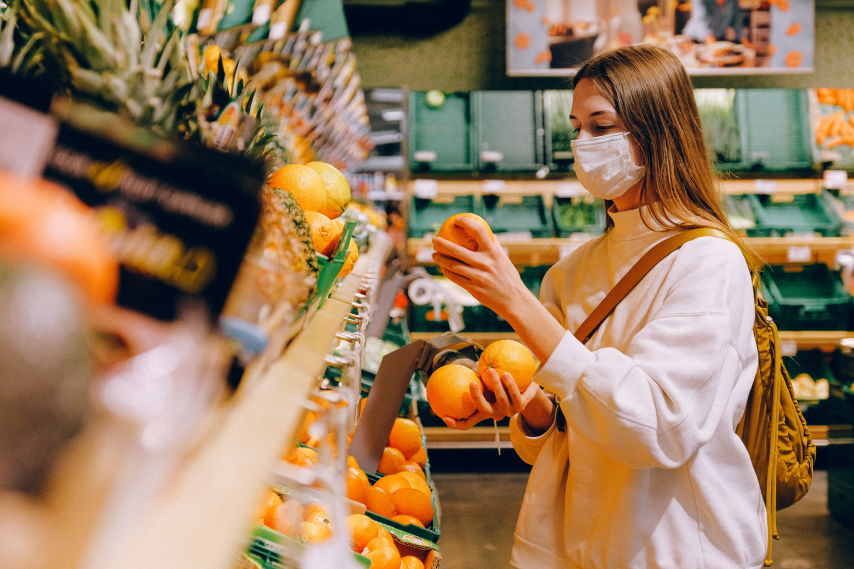
Emergency Allotment Toolkit
Explore the Communications Toolkit
Improving Access to Nutrition Act (H.R. 1510) Fact Sheet
Read the fact sheet
Opportunities to Ensure Benefit Adequacy Through Administrative Advocacy
- USDA Waivers & Guidance
- Time Limits
- Resources for Public Health Emergency (PHE) Unwinding
- FNS Waiver Database ToolFNS’s waiver database tools help users quickly find information on different state administrative waivers currently in place. Advocates can learn about their state certification waivers, state administration waivers, and State EBT and Retail waivers. You can use the link below to access these waiver databases available through FNS. For technical assistance regarding state waivers, please contact Gina Plata-Nino at gplata-nino@frac.org.
- Current Certification Waivers (as of 03/27/23)
- State Administration Waivers (as of 10/9/19)
- Current State EBT and Retailer Waivers (as of 05/24/23)
See Also
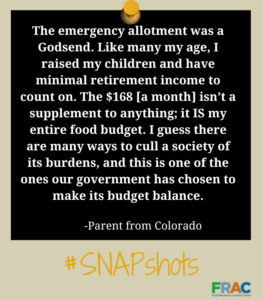
Spread the Word: Share FRAC Chat Blogs
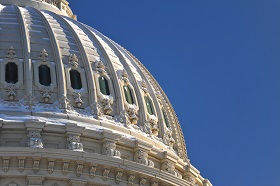
Offset in Omnibus Would Cut SNAP and
Hasten Hunger Cliff for Millions
“Premature cuts to SNAP EAs would hasten the hunger cliff for millions of people with low incomes as soon as March 2023. SNAP recipients of all ages will lose benefits, but the steepest cliff will be for older adults at the minimum benefit level who will have their monthly SNAP benefits fall from $281 to $23.”

Priorities for Closing SNAP Gaps and
Addressing Looming Hunger Cliff
“New guidance from U.S. Department of Agriculture’s Food and Nutrition Service (FNS) urges state Supplemental Nutrition Assistance Program (SNAP) agencies to leverage federal SNAP reimbursement funds for SNAP outreach that prioritizes work to help participants transition to regular intake rules after emergency allotments end.”
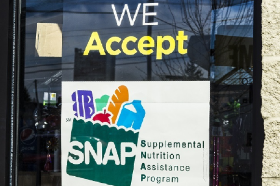
A Strengthen SNAP Agenda to Address the Hunger Cliff
– Part 1, Part 2
This two-part blog summarizes the array of SNAP aid tied to the duration of the PHE declaration (except for Emergency Allotments), focuses on procedural flexibilities available during COVID-19, and presents strategies to promote efficient and equitable SNAP access and good customer service before, during, and beyond any post-PHE transitional period.

New Research Shows Many Low-Income Households Have
Little Financial Cushion as Hunger Cliff Looms
“The responses of Propel SNAP customers surveyed in November 2021 and recent data analyses reported by The New York Times underscore the precarious financial situation many low-income households face”

Addressing the Looming Hunger Cliff:
Improve SNAP Deductions
Households with low incomes face hard choices between paying for food and paying for other basics such as shelter and medicine. Those choices will get even harder for participants when the COVID-19 health emergency ends and, with it, the SNAP Emergency Allotments that have boosted benefits temporarily. Most SNAP participants will lose an average of $82 a month.

On the Road to the 2023 Farm Bill: Stakeholder and
Public Support for SNAP Investments
“Unless Congress takes action, SNAP Supplemental Allotments, suspension of SNAP time limits on unemployed and underemployed adults, and reduced barriers to SNAP for college students all are slated to sunset.”

New Surveys Find Clear Public Support for
SNAP Expansions
“Two surveys released this month have found strong public support for enhanced Supplemental Nutrition Assistance Program (SNAP) funding.”

A Lifeline During COVID-19: The Impact of SNAP
Boosts for Older Adults
“During the interviews, the older adults shared key ways the increased SNAP benefits had positive impacts on their lives, including on their food purchases, health, ability to pay bills, juggle other expenses, and weather the COVID-19 pandemic”

Let’s End Time Limits on SNAP Benefits
“Even as a ‘hunger cliff’ is hitting Supplemental Nutrition Assistance Program (SNAP) households in March, and tens of millions of people are losing an average of $82 a person a month in grocery money, some conservatives are pushing for harsh changes to further undermine SNAP’s access for unemployed and underemployed people. ”

History Shows Congress Should End SNAP Time Limits
“As the Senate takes up debt limit legislation, and Members of Congress continue working toward a 2023 Farm Bill, we need to set the record straight on the current SNAP time limit rules, how they were enacted and implemented, and why, instead of worsening them, Congress should pass legislation, the Improving Access to Nutrition Act of 2023 (H.R. 1510), to end SNAP time limits entirely.”
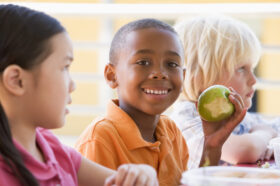
Communication Is Key for SNAP, Especially in a Time of Policy Change
“Changes are happening in Supplemental Nutrition Assistance Program (SNAP) eligibility and operations in summer 2023, both because SNAP temporary policies during the pandemic are “unwinding” and because the recently enacted debt ceiling law amends the population groups subject to SNAP time limit rules.”

New SNAP Program Access Index Data Help in Identifying Factors for Better SNAP Performance
“Recently released national and state-by-state estimates of the degree to which the Supplemental Assistance Program (SNAP) is reaching residents with lower incomes are a helpful tool for assessing the program’s reach and gaps.”
Need further assistance? Please contact FRAC’s SNAP team.


